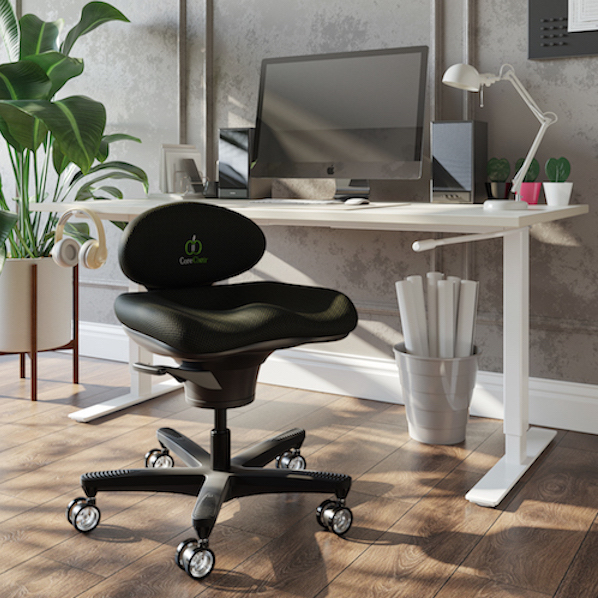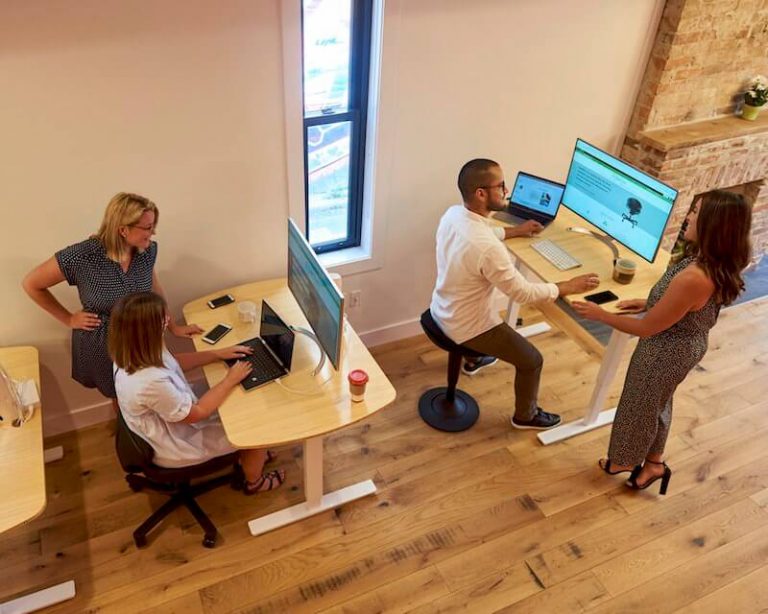The modern office environment has begun to see a transformation in seating through the introduction of active chairs for office. This innovation, mostly inspired by the dynamic movement of an exercise ball for core strengthening and balance, addresses concerns about sedentary lifestyles that come with traditional office jobs. Active chairs for office are designed to promote movement, some enhance posture, and improve comfort during working hours by enabling various movements like swaying that engages various physiological systems that include vestibular stimulation, neurological pathways, circulation of blood and lymph, joint mobilization and of course muscle activation.These active chairs for office encourage continuous or intermittent engagement of core stabilizing muscle groups, thereby minimizing often distracting back pain while increasing focus and productivity levels for users. The increased popularity shows an effort towards more health-conscious work setups blending well-being/comfort alongside professional demands within offices today!
Ergonomic support is often excessive in traditional chairs, resulting in health issues for those who use them extensively. Due to their rigidity and inability to encourage the user’s body toward movement, these chairs can actually encourage improper posture that exacerbates back pain – a common issue among office workers. Fixed height and angles also limit accommodating different bodies types & work styles leading further discomforts & potential problems with musculoskeletal strain.This reduces natural body movement which damages muscle activity necessary for circulation- hence there exists an urgent need of ergonomic alternatives within workplaces. But why is the movement encouraged by active sitting chairs an important consideration? Simply put, our bodies are designed to move and good movement leads to good health.
Modern workplaces often require extended periods of sitting, which can have detrimental effects on both health and productivity. Sitting for prolonged durations has been linked to an increased risk of cardiovascular diseases, obesity, and diabetes due to a reduced metabolic rate, as well as many more deleterious health issues. In addition to physical health risks, long hours spent in chairs where healthy and natural movement is restricted may detrimentally affect work performance by decreasing concentration levels and energy levels. Moreover, consistent poor posture resulting from innapropriate seated positions may lead to musculoskeletal problems that inflict discomfort or potential future ailments.
Fortunately though, these adverse conditions are preventable through properly designed active chairs for office by incorporating consistent, even low intensity breaks with movement into daily routines. An active lifestyle is the key towards mitigating significant negative impacts arising out of extended spans at desks-chair settings in a somewhat restricted, possibly diminishing posture, while working efficiently with elevated job fulfillment expectations.
Understanding active chairs for office
Active chairs that counteract the detrimental consequences of sitting static are considered more beneficial for extended periods by boosting activity especially when they encourage good posture. Innovative active seating options inspired by balance ball, like active sitting chair that perform similarly to traditional chairs but promote movement, as well as sit-stand desk seats, allow for additional movements while encouraging a more dynamic overall seating experience. By managing slight instability factors, while encouraging good posture, these options strengthen core muscles and enhance spinal alignment to decrease back pain whilst improving general wellbeing throughout work hours.
Many people do not fully understand the benefits of a moving chair and believe that if the chair is moving then this activity, as minimal as it might be, will contribute to fatigue over the course of the work day. In reality, even this slight to moderate movement is determined to be beneficial as it contributes to increased blood flow, vestibular stimulation and so much more. When people endure a long day in a static chair, possibly with compromised posture, there is a high tendency to fidget in an attempt to change position in the pursuit of comfort. The documented lack of blood flow from sitting static actually contributes to fatigue and is detrimental to productivity.
A study conducted by Guelph University, investigating these active sitting benefits using the CoreChair, determined that there was a significant reduction in “the commission of errors” compared to traditional static sitting, when subjected to a 4 hour sitting study and employing a SART test to measure attention and perceived productivity.
The Benefits of active chairs for office
Ergonomic dynamic seating, commonly known as active chairs for office, offer a plethora of advantages for office workers who spend extended hours at their desks. These active chairs for office promote low intensity and high duration movements that when providing optimal body alignment, effectively lower the likelihood of musculoskeletal problems often related to sedentary desk jobs. The Mayo Clinic introduced a concept referred to as NEAT, non-exercise activity thermogenesis. This refers to any activity that encourages low intensity long duration movement that in turn stimulates the body’s physiology, is considered to provide a desirable and cumulative conditioning for the person. By encouraging good posture and activating core muscles, active chairs lessen back discomfort while boosting concentration and output efficiency. Furthermore, these innovative active chairs for office integrate light physical activity into daily work routine thereby enhancing overall levels of health.
Incorporating active chairs for office into the workplace
Promoting health and wellness in the workplace through active chairs for the office is a progressive strategy, that is often met with skepticism and requires a level of education, especially for those whose overall body awareness is not a priority. These creative seating options inspire workers to make subtle and consistent movements and adopting different postures throughout their workday, counteracting the harmful effects of extended static sitting. Companies that introduce active chairs for offices demonstrate a dedication and understanding of these health benefits toward maintaining employees’ physical fitness and general health, while potentially cutting healthcare expenses and enhancing engagement levels for better overall productivity and employee job satisfaction.
In an attempt to incorporate frequent healthy movement as well as sitting among staff, try incorporating standing meetings to counteract the impact of extended periods of sitting. While active chairs for the office do provide physiological stimulation, the engagement of large muscle groups, such as the gluteus maximus, quadraceps and more, encourages even larger volumes of blood and lymph circulation, which generally enhance the performance for all. Further initiatives can be provided by offering adaptable desks that facilitate a seamless transition between seated and standing postures. Introducing brief exercise or stretching breaks throughout the day also serves to encourage physical activity amongst workers. Commuting on foot or bicycle incentivization programs should provide further backing for active lifestyles in this regard too. Finally, educating employees about active seating alternatives such as dynamic ergonomic chairs can overall improve their productivity levels alongside personal well-being enhancements possible through these approaches being implemented successfully within workplaces, whether at home or in the office.
Overcoming Resistance and Challenges
The adoption of active chairs in the workplace raises a common concern regarding their possible impact on productivity. Detractors contend that the dynamic nature of these seats could divert employees’ attention from their duties, and there are concerns about an initial adjustment period where discomfort or unfamiliarity may hinder efficiency temporarily. Moreover, critics doubt the cost-effectiveness associated with implementing ergonomic solutions such as this – particularly for bigger organizations: outfitting every workstation with an active chair might have significant financial implications which skeptics question whether it’s worth investing in them at all.
Many progressive SME’s have adopted CoreChair and other active sitting chairs for the office, recognizing the health benefits and the psychological value of demonstrating concern for the health of their employees, not to mention the anticipated outcomes of increased productivity and job satisfaction.
While not all humans are created physically equal, it is clear that introducing such an innovation to the organization may not be immediately embraced by all, but it has been demonstrated that while adoption of this new sitting experience may vary, most over time do adapt and enjoy the benefits of movement while they work.
An active sitting chair such as CoreChair, incorporates a very effective postural positioning feature that often takes an individual from a chronic slumped position that they adopted from the use of a traditional chair over time, and places them in an optimal upright sitting posture. This collective reorganization of the relationship between joints and recruitment of core stabilizing muscles in particular, may contribute to some mild discomfort, much like attending an exercise gym after a long absence, and engaging in a new group of exercises. In this scenario, new working muscle groups may tend to protest until they adapt and in the long term contribute to an overall strengthening of these core stabilizing muscles. Of course, the vast majority of CoreChair users, readily adapt and enjoy the relief of optimal pelvic support and positioning and these training effect that their core stabilizing muscles endure, goes unnoticed.
Future Trends and Innovations of active chairs for office
The evolution of office seating suggests that a combination of state-of-the-art technology and ergonomic design will produce workspaces that enhance well-being and productivity. Advancements have been slowly introduced but the apparent value of integrating active sitting is becoming better understood and embraced. Somewhere in the not too distant future, there exists a solution that blends the health benefits of active sitting as well as the inherent tendency to relax intermittently. CoreChair’s contribution to this phenomena has been manifested in a fully ergonomic active sitting chair that incorporates a taller and yet dynamic back support, that is preparing for commercial launch through 2024-2025.
This fully dynamic active sitting chair will clearly bridge the gap of the skeptical, while delivering a much healthier sitting solution for all users.
Conclusion
Innovatively designed active chairs for office possess the capability to transform workplace comfort and elevate employee well-being. Some of these active chairs for office promote movement while maintaining a natural posture, offering relief from prolonged sitting which commonly results in complaints of back pain and fatigue. The improvement in physical ease leads to better concentration levels and increased productivity, highlighting how mindfully created office furniture can significantly impact both the general health and efficiency within a work setting.
To sum up, the progress in office seating is not merely a passing fad; it plays an essential role in establishing healthy and dynamic workplaces. By welcoming novel techniques to seating, employers can greatly improve their staff’s wellbeing and effectiveness. These breakthroughs in ergonomic design do more than just alleviate physical discomfort – they foster mental concentration and involvement as well. Finally, investing in top-notch adaptable seats displays care for employees’ general health which goes towards building livelier, proficient work environments that are sure to succeed with greater ease.





